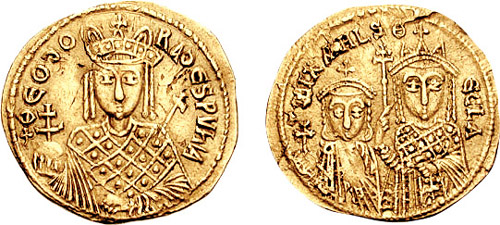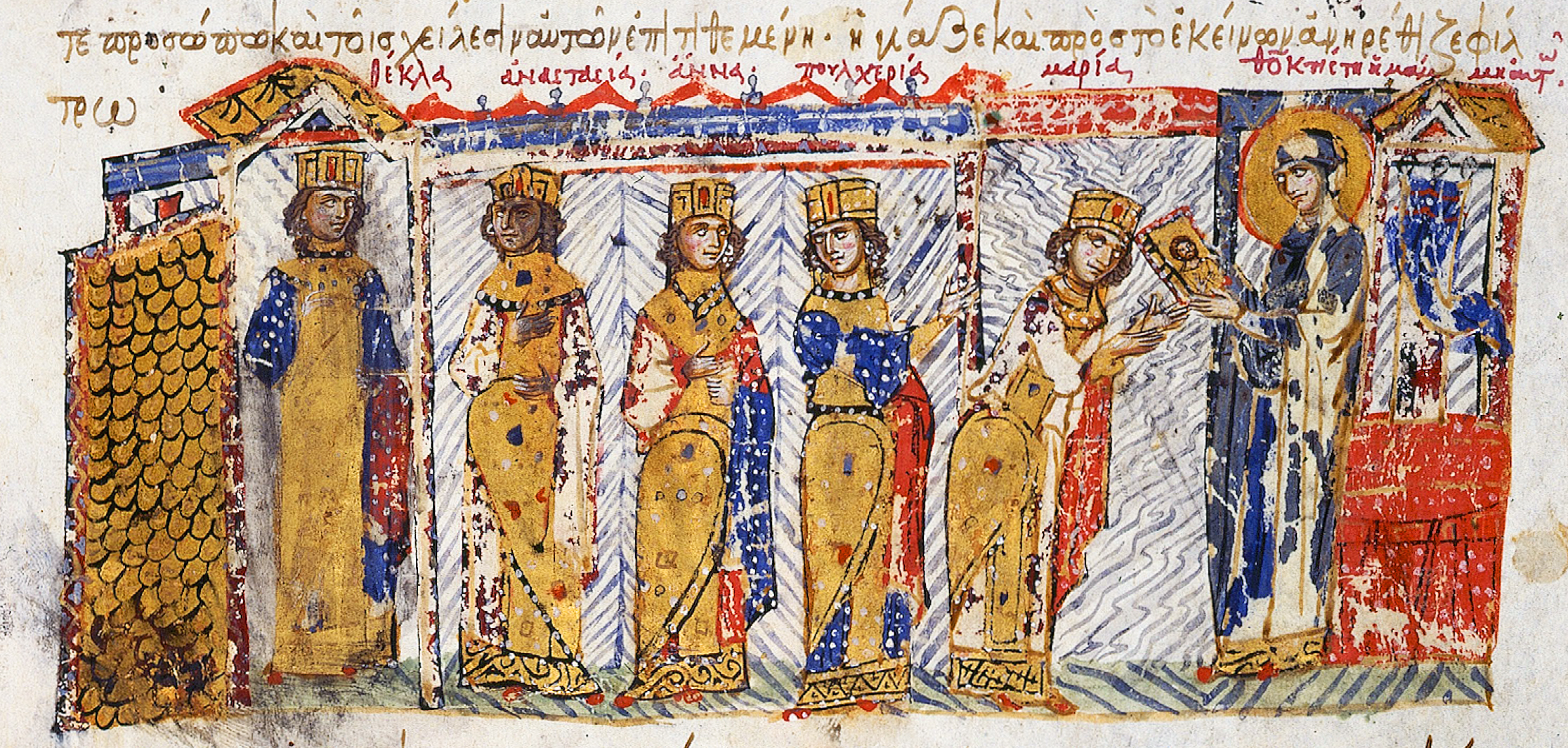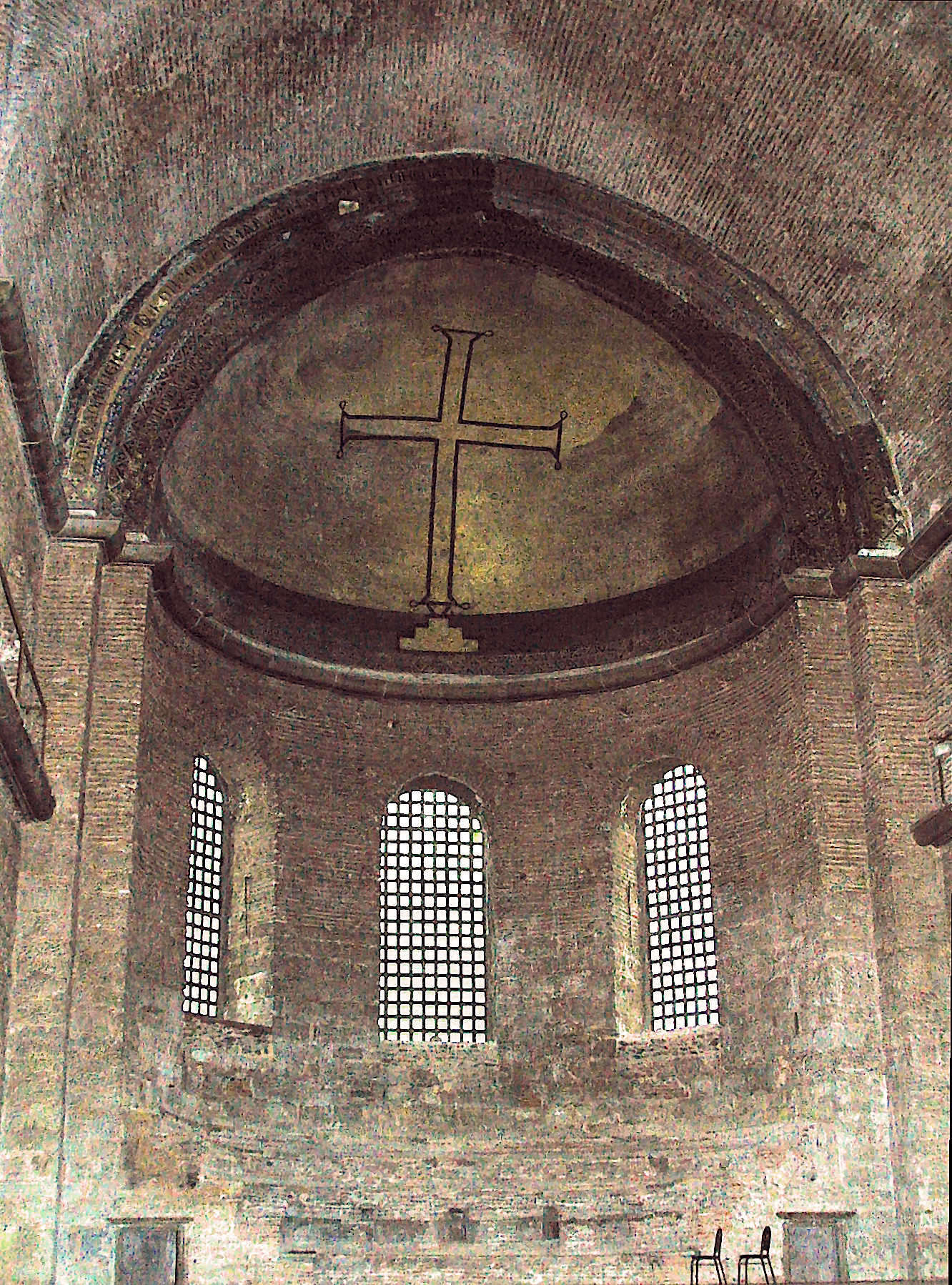|
842
__NOTOC__ Year 842 ( DCCCXLII) was a common year starting on Sunday of the Julian calendar, the 842nd year of the Common Era (CE) and Anno Domini (AD) designations, the 842nd year of the 1st millennium, the 42nd year of the 9th century, and the 3rd year of the 840s decade. Events By place Byzantine Empire * January 20 – Emperor Theophilos dies of dysentery at Constantinople, after a 12-year reign in which he expended much effort defending the eastern frontier against the invading Muslim Arabs. Theophilos is succeeded by his 2-year-old son Michael III, with his mother Theodora as regent and the 'temporary' sole ruler of the Byzantine Empire. * February 19 – The Medieval Iconoclastic Controversy ends, as a council in Constantinople formally reinstates the veneration of icons in the churches. Europe * February 13 – Last reported sighting of the comet X/841 Y1 according to the '' Annals of Fontenelle''. * February 14 – Oaths of Strasbourg: King ... [...More Info...] [...Related Items...] OR: [Wikipedia] [Google] [Baidu] |
Theophilos (emperor)
Theophilos (, sometimes Latinised as Theophilus; 20 January 842) was Byzantine Emperor from 829 until his death in 842. He was the second emperor of the Amorian dynasty and the last emperor to support iconoclasm. Theophilos was well-educated in the imperial household but upon his accession to the throne was met with the dual threat of the Abbasid Caliphate in Asia Minor and the Aghlabids in Sicily. He personally led the armies in his long war against both the Abbasid Caliphate and the Aghlabids in Sicily, beginning in 831. He won fleeting victories but the retaliation of Caliph al-Mu'tasim () was devastating, as was most humiliating in the Sack of Amorion in 838, the ancestral home of Theophilos' Amorian dynasty. Internal strife within the Caliphate allowed the Byzantines to recover. Theophilos engaged in many construction and renovation projects. One of his closest allies was the learned and cosmopolitan John the Grammarian, and they both improved relations with the Caliph ... [...More Info...] [...Related Items...] OR: [Wikipedia] [Google] [Baidu] |
Theodora (wife Of Theophilos)
Theodora ( Greek: Θεοδώρα; 815 – c. 867), sometimes called Theodora the Armenian or Theodora the Blessed, was Byzantine empress as the wife of Byzantine emperor Theophilos from 830 to 842 and regent for the couple's young son Michael III, after the death of Theophilos, from 842 to 856. Theodora is most famous for bringing an end to the second Byzantine Iconoclasm (814–843), an act for which she is recognized as a saint in the Eastern Orthodox Church. Though her rule saw the loss of most of Sicily and failure to retake Crete, Theodora's foreign policy was otherwise highly successful; by 856, the Byzantine Empire had gained the upper hand over both the Bulgarian Empire and the Abbasid Caliphate, and the Slavic tribes in the Peloponnese had been forced to pay tribute, all without decreasing the imperial gold reserve. Possibly of Armenian descent, Theodora was born into a rural family of traders and military officials in Paphlagonia. In 830 she was selected by Euph ... [...More Info...] [...Related Items...] OR: [Wikipedia] [Google] [Baidu] |
Oaths Of Strasbourg
The Oaths of Strasbourg were a military pact made on 14 February 842 by Charles the Bald and Louis the German against their older brother Lothair I, the designated heir of Louis the Pious, the successor of Charlemagne. One year later the Treaty of Verdun would be signed, with major consequences for Western Europe's geopolitical landscape. Louis the German swore his oath in an early form of Old French so that the soldiers of Charles the Bald could understand him. Likewise, the latter recited his in Old High German so that Louis's soldiers would understand. The Romance section of the Oaths is of special importance to historical linguistics, as it is the oldest extant document in France that was written deliberately and consistently in a form of Romance languages, Romance. Context Centuries after the fall of the Western Roman Empire, Charlemagne, who had conquered much of its former territory, announced its Renovatio imperii Romanorum, restoration. Upon his death, he passed this ... [...More Info...] [...Related Items...] OR: [Wikipedia] [Google] [Baidu] |
Michael III
Michael III (; 9/10 January 840 – 24 September 867), also known as Michael the Drunkard, was Byzantine emperor from 842 to 867. Michael III was the third and traditionally last member of the Amorian dynasty, Amorian (or Phrygian) dynasty. He was given the disparaging epithet ''the Drunkard'' () by the hostile historians of the succeeding Macedonian dynasty, but modern historical research has rehabilitated his reputation to some extent, demonstrating the vital role his reign played in the resurgence of Byzantine power in the 9th century. He was also the youngest person to bear the imperial title, as well as the youngest to succeed as senior emperor. Life Early life and regency Michael was the youngest child of the emperor Theophilos (emperor), Theophilos and his empress Theodora (wife of Theophilos), Theodora. His precise date of birth is uncertain, but the balance of available evidence supports a birthdate in early 840, probably on 9 or 10 January. He was coronation of the ... [...More Info...] [...Related Items...] OR: [Wikipedia] [Google] [Baidu] |
9th Century
The 9th century was a period from 801 (represented by the Roman numerals DCCCI) through 900 (CM) in accordance with the Julian calendar. The Carolingian Renaissance and the Viking raids occurred within this period. In the Middle East, the House of Wisdom was founded in Abbasid Baghdad, attracting many scholars to the city. The field of algebra was founded by the Muslim polymath al-Khwarizmi. The most famous Islamic scholar Ahmad ibn Hanbal was tortured and imprisoned by Abbasid official Ahmad ibn Abi Du'ad during the reign of Abbasid caliph al-Mu'tasim and caliph al-Wathiq. In Southeast Asia, the height of the Mataram Kingdom happened in this century, while Burma would see the establishment of the major kingdom of Pagan. Tang China started the century with the effective rule under Emperor Xianzong and ended the century with the Huang Chao rebellions. In America, the Maya experienced widespread political collapse in the central Maya region, resulting in internecin ... [...More Info...] [...Related Items...] OR: [Wikipedia] [Google] [Baidu] |
January 20
Events Pre-1600 * 250 – Pope Fabian is martyred during the Decian persecution. *1156 – Finnish peasant Lalli kills English clergyman Henry (bishop of Finland), Henry, the Bishop of Turku, on the ice of Köyliönjärvi, Lake Köyliö. *1265 – The Simon de Montfort's Parliament, first English parliament to include not only Lords but also representatives of the major towns holds its first meeting in the Palace of Westminster, now commonly known as the "Houses of Parliament". *1320 – Duke Wladyslaw Lokietek becomes History of Poland during the Piast dynasty#Late Piast dynasty and reunification, king of Poland. *1356 – Edward Balliol surrenders his claim to the List of Scottish monarchs#House of Balliol (1292–96), Scottish throne to Edward III of England, Edward III in exchange for an English pension. *1401 – The Taula de canvi de Barcelona, Taula de canvi (Catalan: "Table of change"), described as Europe's first-ever public bank, began operation ... [...More Info...] [...Related Items...] OR: [Wikipedia] [Google] [Baidu] |
Louis The German
Louis the German (German language, German: ''Ludwig der Deutsche''; c. 806/810 – 28 August 876), also known as Louis II of Germany (German language, German: ''Ludwig II. von Deutschland''), was the first king of East Francia, and ruled from 843 to 876 AD. Grandson of emperor Charlemagne and the third son of Louis the Pious, emperor of Francia, and his first wife, Ermengarde of Hesbaye, he received the appellation ''Germanicus'' shortly after his death, when East Francia became known as the kingdom of Germany. After protracted clashes with his father and his brothers, Louis received the East Frankish kingdom in the Treaty of Verdun (843). His attempts to conquer his half-brother Charles the Bald's West Frankish kingdom in 858–59 were unsuccessful. The 860s were marked by a severe crisis, with the East Frankish rebellions of the sons, as well as struggles to maintain supremacy over his realm. In the Treaty of Meerssen he acquired Lotharingia for the East Frankish kingdom in 87 ... [...More Info...] [...Related Items...] OR: [Wikipedia] [Google] [Baidu] |
February 14
It is observed in most countries as Valentine's Day. Events Pre-1600 * 748 – Abbasid Revolution#Persian phase, Abbasid Revolution: The Kaysanites Shia#History, Hashimi rebels under Abu Muslim Khorasani take Merv, capital of the Umayyad Caliphate, Umayyad province Greater Khorasan, Khorasan, marking the consolidation of the Abbasid Caliphate, Abbasid revolt. * 842 – Charles the Bald and Louis the German swear the Oaths of Strasbourg in the French and German languages. *1014 – Pope Benedict VIII crowns Henry II, Holy Roman Emperor, Henry of Bavaria, Monarchy, King of Germany and of Italy, as Holy Roman Emperor. *1130 – The troubled 1130 papal election exposes a rift within the College of Cardinals. *1349 – Several hundred History of the Jews in Europe, Jews are Death by burning, burned to death by mobs while the remaining Jews are Strasbourg massacre, forcibly removed from Strasbourg. *1530 – Conquistador, Spanish conquistadores, led by Nuño ... [...More Info...] [...Related Items...] OR: [Wikipedia] [Google] [Baidu] |
Iconoclastic Controversy
The Byzantine Iconoclasm () are two periods in the history of the Byzantine Empire when the use of religious images or icons was opposed by religious and imperial authorities within the Ecumenical Patriarchate (at the time still comprising the Roman-Latin and the Eastern-Orthodox traditions) and the temporal imperial hierarchy. The First Iconoclasm, as it is sometimes called, occurred between about 726 and 787, while the Second Iconoclasm occurred between 814 and 842. According to the traditional view, Byzantine Iconoclasm was started by a ban on religious images promulgated by the Byzantine Emperor Leo III the Isaurian, and continued under his successors. It was accompanied by widespread destruction of religious images and persecution of supporters of the veneration of images. The Papacy remained firmly in support of the use of religious images throughout the period, and the whole episode widened the growing divergence between the Byzantine and Carolingian traditions in wha ... [...More Info...] [...Related Items...] OR: [Wikipedia] [Google] [Baidu] |
Constantinople
Constantinople (#Names of Constantinople, see other names) was a historical city located on the Bosporus that served as the capital of the Roman Empire, Roman, Byzantine Empire, Byzantine, Latin Empire, Latin, and Ottoman Empire, Ottoman empires between its consecration in 330 until 1930, when it was renamed to Istanbul. Initially as New Rome, Constantinople was founded in 324 during the reign of Constantine the Great on the site of the existing settlement of Byzantium, and shortly thereafter in 330 became the capital of the Roman Empire. Following the collapse of the Western Roman Empire in the late 5th century, Constantinople remained the capital of the Eastern Roman Empire (also known as the Byzantine Empire; 330–1204 and 1261–1453), the Latin Empire (1204–1261), and the Ottoman Empire (1453–1922). Following the Turkish War of Independence, the Turkish capital then moved to Ankara. Although the city had been known as Istanbul since 1453, it was officially renamed as Is ... [...More Info...] [...Related Items...] OR: [Wikipedia] [Google] [Baidu] |
Byzantine Empire
The Byzantine Empire, also known as the Eastern Roman Empire, was the continuation of the Roman Empire centred on Constantinople during late antiquity and the Middle Ages. Having survived History of the Roman Empire, the events that caused the fall of the Western Roman Empire in the 5th centuryAD, it endured until the fall of Constantinople to the Ottoman Empire in 1453. The term 'Byzantine Empire' was coined only after its demise; its citizens used the term 'Roman Empire' and called themselves 'Romans'. During the early centuries of the Roman Empire, the western provinces were Romanization (cultural), Latinised, but the eastern parts kept their Hellenistic culture. Constantine the Great, Constantine I () legalised Christianity and moved the capital to Constantinople. Theodosius I, Theodosius I () made Christianity the state religion and Greek gradually replaced Latin for official use. The empire adopted a defensive strategy and, throughout its remaining history, expe ... [...More Info...] [...Related Items...] OR: [Wikipedia] [Google] [Baidu] |
1st Millennium
File:1st millennium montage.png, From top left, clockwise: Depiction of Jesus, the central figure in Christianity; The Colosseum, a landmark of the once-mighty Roman Empire; Kaaba, the Great Mosque of Mecca, the holiest site of Islam; Chess, a new board game, becomes popular around the globe; The Western Roman Empire falls, ushering in the Early Middle Ages; The skeletal remains of a young woman, known as the "ring lady", killed by the eruption of Mount Vesuvius in AD 79; Attila the Hun, leader of the Hunnic Empire, which takes most of Eastern Europe (Background: Reproduction of ancient mural from Teotihuacan, National Museum of Anthropology, Mexico City), 400px, thumb rect 9 6 182 173 Jesus Christ rect 192 5 411 169 Roman Empire rect 420 16 560 101 Great Mosque of Mecca rect 416 112 561 212 Chess rect 13 189 171 356 Attila the Hun rect 184 177 308 346 Eruption of Mount Vesuvius in 79 AD rect 313 222 559 352 Early Middle Ages rect 1 1 566 394 Teotihuacan rect 1 1 566 394 Pilate's ... [...More Info...] [...Related Items...] OR: [Wikipedia] [Google] [Baidu] |









